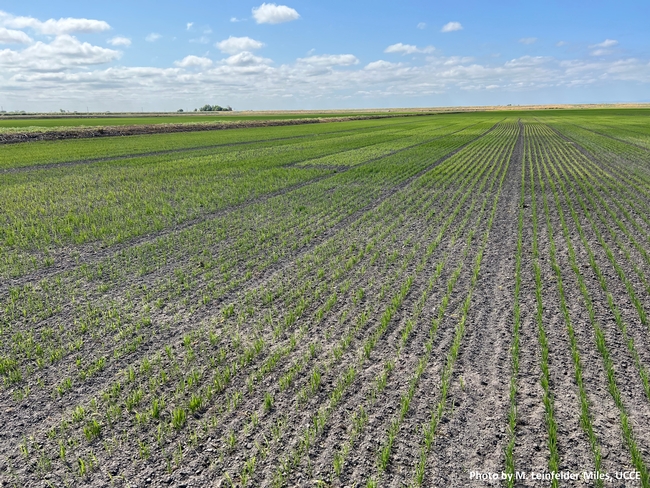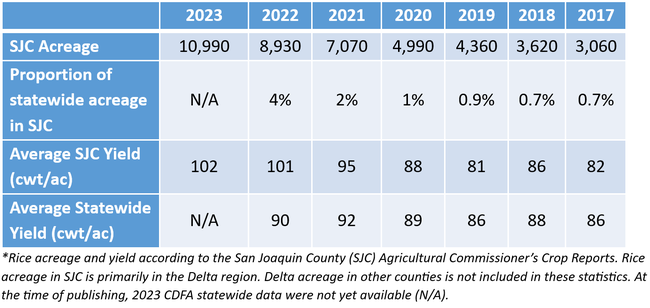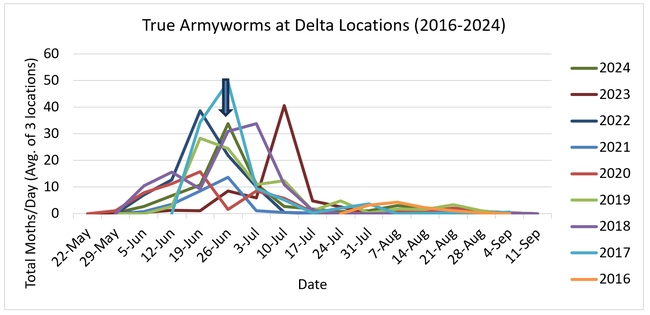- Author: Michelle M Leinfelder-Miles
Delta rice acreage has been steadily increasing, and yields are comparable with the statewide average. I estimate that acreage approached, if not exceeded, 15,000 acres in 2024. This article is my seasonal update on UCCE Delta rice research and observations.
Table 1. Rice acreage and yield.
Variety Trial: UCCE collaborates with the California Rice Experiment Station to evaluate commercial varieties and advanced breeding lines. The San Joaquin County Delta was one of eight locations in the 2024 statewide trial. The Delta is the only drill-seeded site and is a test site for very-early maturing varieties because it has cooler growing conditions than other rice growing regions of the state. Variety trial results will be available in the February 2025 newsletter.
Armyworm Monitoring: In 2024, we monitored for true armyworms on three Delta farms, and moth catches peaked around July 1st (Fig. 1). I observed that feeding damage was highly variable across the three farms but also across fields on the same farm. This has important implications for in-season management and highlights the importance of scouting for crop damage and the presence of worms. UC IPM guidelines provide monitoring guidelines and treatment thresholds. While a second peak has sometimes been observed in the Sacramento Valley, we have not observed a second peak after heading in the Delta.
Figure 1. Delta true armyworm trap counts, 2016-2024. Data represent the average moth catches across nine traps (three traps at three different farms).
Weedy Rice: We need to stay vigilant in our efforts to prevent the spread and manage weedy rice. Early in the season, weedy rice is often mistaken for watergrass because it grows taller than the cultivated rice. However, I have noticed that watergrass (and barnyardgrass) will head sooner than weedy rice, and weedy rice has a lime green color in full light. There is a video on the CA Weedy Rice website that can help with identification or call me if you would like help. In-season management includes rogueing or spot spraying before viable seed is produced. The organic herbicide Suppress is registered for spot spraying. Post-harvest management should include straw chopping, but not incorporation, and winter flooding. This will keep seed on the soil surface where it can potentially deteriorate over the winter. With my colleagues, Whitney Brim-DeForest and Luis Espino, I will host a meeting for the Delta rice industry in early 2025 to provide weedy rice research updates and management information. Stay tuned for the meeting announcement.
Cover Cropping: With funding from the CDFA Healthy Soils Program and CA Rice Research Board, we are evaluating whether cover cropping improves soil carbon and nitrogen dynamics in the rice system. We are also assessing cover crop species performance, like survivability and biomass production. Since rice may be grown over multiple seasons without rotation, cover crops may provide an opportunity to introduce plant diversity, including nitrogen-fixing legumes. While the 2022-23 winter season was excessively wet, which hindered cover crop establishment, the 2023-24 season started off dry, so sowing and establishment were successful. We observed that the brassicas emerged quickly and started covering the soil after just one month, but when rainfall became more frequent after the new year, the brassicas died off. In contrast, the two vetches and balansa clover started off slowly but had vigorous stands by early spring, despite the wet conditions. For more information on these trial results, please visit my blog article. The 2024-25 winter season will be our third and final year of trialing.
Disease Observations: In past years, I have been called out to fields to help diagnose diseases, which were later confirmed as stem rot, aggregate sheath spot, or rice blast. The 2024 season, however, was a relatively light disease year, and my colleague, Luis Espino, also observed that in the Sacramento Valley. Just to recap, it is important to scout for these diseases at late-tillering and early-heading because fungicide treatments are most effective when applied between late-boot and early-heading. Rice blast may be exacerbated by too much nitrogen, and stem rot and aggregate sheath spot by low potassium (K), so proper plant nutrition is a good strategy to mitigate disease. K can be limiting in some Delta soils, so one of my future goals is to do K fertilizer rate trialing to determine if it can reduce disease incidence and/or boost yields.
Herbicide Resistance Testing: UCCE, under the direction of Extension Specialist Kassim Al-Khatib, provides herbicide resistance testing for rice growers. If you suspect that weeds have developed resistance to certain herbicides, please collect mature weed seeds at the end of the season and submit them to me.
Alternate Wetting and Drying: Earlier this year, I applied for funding from the Delta Science Program to evaluate the practice of Alternate Wetting and Drying (AWD) in the Delta. AWD is a management practice where a flooded field is temporarily drained during the growing season and then re-flooded. Research from other states and countries has shown that the practice can reduce methane emissions from rice fields, but there has not been research done in the Delta, with its unique soil and climate conditions. If the grant is awarded, this project would begin during the 2025 season.
I want to take this opportunity to thank all the growers who collaborated with us on these projects. I wish everyone a happy, healthy end to 2024.






